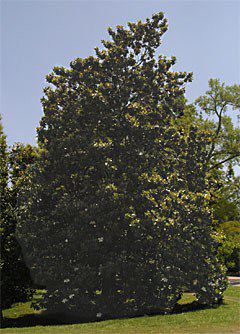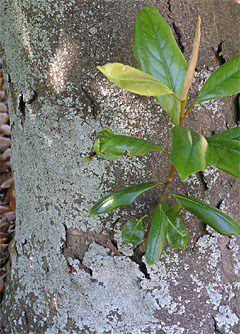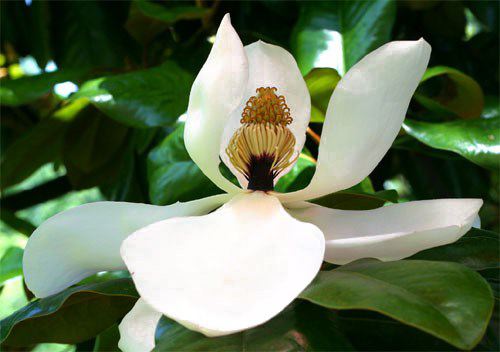|
|
|||
|
|
|||
(Back to Preceding Week; on to Next Week)
|
FAIREST FLOWER OF THE SOUTH When we left South Carolina for grad school in Minnesota, we learned what cold and snow were really all about. During four very long winters studying Blue Jays in the North Star State, we suffered while numerous records were broken for snow depth, low temperatures, and consecutive days of snow cover. Shivering all the while, we dreamed of moving back to the Carolina Piedmont, and as our last field season drew to a close, we contacted a realtor with an all-too-specific wish list of what we wanted in the way of York County property: a livable dwelling within our price range; several acres of land; water (either stream or pond); some established trees and shrubs; and--as a true sign we were coming back home to much warmer climes--a Southern Magnolia in the front yard. As impossible as it might seem, real estate agent Marge Van Remmen found a listing with all these criteria, so we quickly closed on the house and 11-acre property in 1982, moved in, named our new residence Hilton Pond, and sat back to admire the magnolia tree in the front yard. The rest--as they say--is history.  Southern Magnolias, one of which is blooming this week at Hilton Pond Center, are well-named. Historically found in the Coastal Plain of the Carolinas, Georgia, and Gulf Coast states at elevations of less than 600', they have been planted extensively well beyond their range--often with mixed success. Some cultivars apear to be more cold tolerant and can survive as far north as Philadelphia. Southern Magnolia is the state flower of Louisiana (whose state tree is Bald Cypress) and Mississippi (for which the magnolia serves double duty). This is one species that seldom grows in monoculture; instead it seems to do best when scattered among American Beech, Sweetgum, and White Ash in rich soils that are well-drained but moist; it also is a component of old Loblolly/Shortleaf Pine forests. Southern Magnolia, whose widespread family (Magnoliaceae) is named for early Dutch botanist Peter Magnol, also does very well as a specimen plant in the middle of an open space, where it will assume a raggedy pyramidal shape (below left) and regularly reaches heights up to 90 feet. The trunk of a large tree is usually straight, up to three feet in diameter, and covered by rather smooth gray bark that may exfoliate in small patches (below right); sprouts can occur almost anywhere along the trunk, from ground level upward. Trunks of older trees are often coated with a heavy layer of gray-green crustose and foliose lichens. Not much grows under a big Southern Magnolia, since the 6"-10" leathery leaves--shiny dark green above and velvety brown beneath (above left)--cast such dense shade; the foliage, slow to rot when it finally does die and falls earthward, also helps choke out any competing vegetation. Mature Southern Magnolias are largely unaffected by wildfire because their bark is not very flammable, and they seldom succumb to hurricanes because of their deep tap root. These are two necessary adaptations for a species that hopes to do well in the Low Country.  . . The sweet-smelling saucer-shaped blossom of Southern Magnolia is among the largest flowers native to North America, reaching 12" or more in breadth--hence its technical name of Magnolia grandiflora. The bloom forms inside a pepper-shaped bud (below left) that opens to form 9 to 14 petals that are fleshy and creamy white. These gradually unfold to reveal an unusual structure that at first glance looks like a pineapple (top photo). At its apex is a crown of greenish-gold carpels that are the female parts of the flower; around their base are numerous rings of white and purple-bottomed pollen-bearing stamens. After fertilization occurs-- usually when bees or scarab beetles bring in pollen from another flower--the stamens fall off and sometimes collect in the concave petals. As stamens drop, the styles--tips of the carpels--shrivel up to reveal an underlying cone-shaped structure (below right) covered with shiny golden fuzz; a hard dark ring beneath it is pitted by a scar left by each stamen.  . . As summer marches on, the magnolia cone increases in length (4"-6") and width and takes on a tan or pinkish hue. By September, the carpels swell and eventually burst, each releasing a scarlet half-inch-long seed that contrasts brilliantly against the deep green magnolia leaves (below right). The colorful fruit is held in place by a semi-elastic silken thread that often allows a seed to dangle from the cone and sway in the wind-- advertising its presence even more. Southern Magnolias--also called Bullbay to differentiate them from Sweetbay or Swampbay, aka the Virginia Magnolia--are cut for lumber. Hard, dense, and rather difficult to work, the wood is sometimes used in furniture. Although Hilton Pond Center is not within the natural distribution of the Southern Magnolia, we're very glad this "fairest flower of the south" survives locally, albeit far from the Coastal Plain. This week, as we sniffed the fragrant blossoms of our largest magnolia tree, we thought again of those frigid grad school winters in Minnesota, had a sudden cold chill despite balmy 80-degree temperatures, and thanked our lucky stars we were back in the Carolina Piedmont where we can comfotably admire our Southern Magnolia all year long. 
All text & photos © Hilton Pond Center Comments or questions about this week's installment?
Thanks to the following fine folks for recent gifts in support of Hilton Pond Center for Piedmont Natural History and/or Operation RubyThroat: The Hummingbird Project. Your tax-deductible contributions allow us to continue writing, photographing, and sharing "This Week at Hilton Pond." (Please see Support if you'd like to make a gift of your own.)
"This Week at Hilton Pond" is written & photographed You may wish to consult our Index of all nature topics covered since February 2000. You can also use our on-line Hilton Pond Search Engine at the bottom of this page. For a free, non-fattening, on-line subscription to |
|
Make direct donations on-line via
Network for Good: |
|
|
Use your PayPal account
to make direct donations: |
|
|
If you like to shop on-line, you please become a member of iGive, through which more than 700 on-line stores from Barnes & Noble to Lands' End will donate a percentage of your purchase price in support of Hilton Pond Center and Operation RubyThroat. For every new member who signs up and makes an on-line purchase iGive will donate an ADDITIONAL $5 to the Center. Please sign up by going to the iGive Web site; more than 150 members have signed up to help. It's a painless, important way for YOU to support our work in conservation, education, and research. |
|
| The highly coveted Operation RubyThroat T-shirt (four-color silk-screened) is made of top-quality 100% white cotton. It highlights the Operation RubyThroat logo on the front and the project's Web address (www.rubythroat.org) across the back.
Now you can wear this unique shirt AND help support Operation RubyThroat: The Hummingbird Project and Hilton Pond Center. Be sure to let us know your mailing address and adult shirt size: Small (suitable for children), Medium, Large, X-Large, or XX-Large. These quality shirts don't shrink! Price ($21.50) includes U.S. shipping. A major gift of $1,000 gets you two Special Edition T-shirts with "Major Donor" on the sleeve. |

Need a Special Gift for a Want to make a If so, why not use our new handy-dandy on-line Google Checkout below to place your secure credit card order or become a Major Donor today? |
|
|
|
|
SPECIES BANDED THIS WEEK * = New species for 2003 WEEKLY BANDING TOTAL 3 species 11 individuals
YEARLY BANDING TOTAL (2003) 44 species 582 individuals
BANDING GRAND TOTAL (since 28 June 1982) 123 species 42,696 individuals
NOTABLE RECAPTURES THIS WEEK (with original banding date, sex, and current age) Ruby-throated Hummingbird (7) Northern Cardinal (2) Carolina Wren (1) Eastern Towhee (1) |
OTHER SIGHTINGS OF INTEREST
 --A Black Ratsnake that regularly patrols the attic of the old farmhouse at Hilton Pond Center somehow found a 3/4" gap in the ceiling right above a pillar on which a pair of House Finches had built a nest. Sharp-eyed Garry Hilton noticed the snake inching down toward the nest on 1 June and alerted us in time for us to encourage it to withdraw back into the ceiling, after which we plugged the hole. Three days later, we were present as the five nestlings fledged, and were quick enough to grab four of them for banding (photo above) before sending them back out for their parents to train. --Another 2" of precipitation during the weekly period interfered with bird netting and banding activities at the Center. --This week was the first time we've seen a female Ruby-throated Hummingbird recaptured on 2 June 2003 after being banded on 13 August 1999; she's now an after- fifth-year bird. There have been three complete field seasons since banding without her being recaptured in a trap or net at Hilton Pond Center. This is also the first time we've had a RTHU go that long between original banding and first recapture, and we can only wonder where she's been in the meantime. |
|
|
|
(Back to Preceding Week; on to Next Week) Up to Top of Page Back to This Week at Hilton Pond Center Current Weather Conditions at Hilton Pond Center |
 You can also post questions for The Piedmont Naturalist |
Join the |
Search Engine for |
|
|